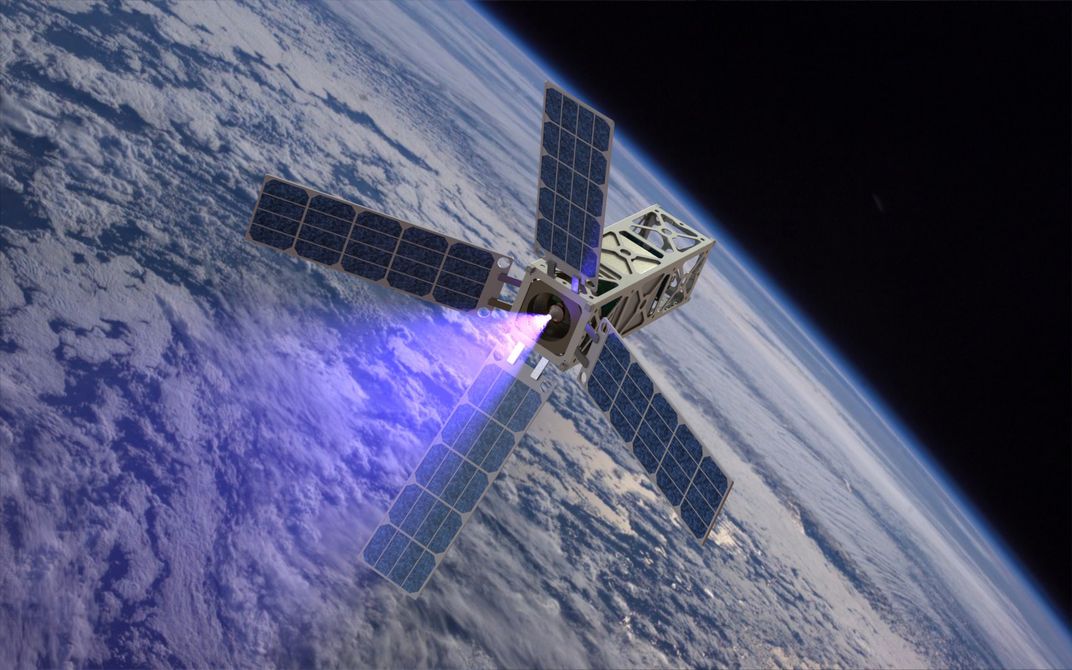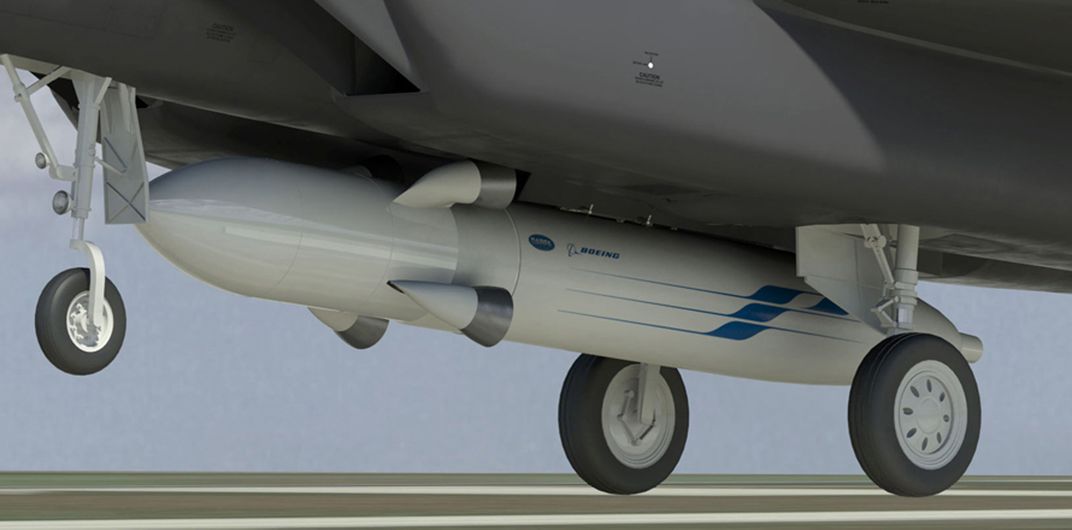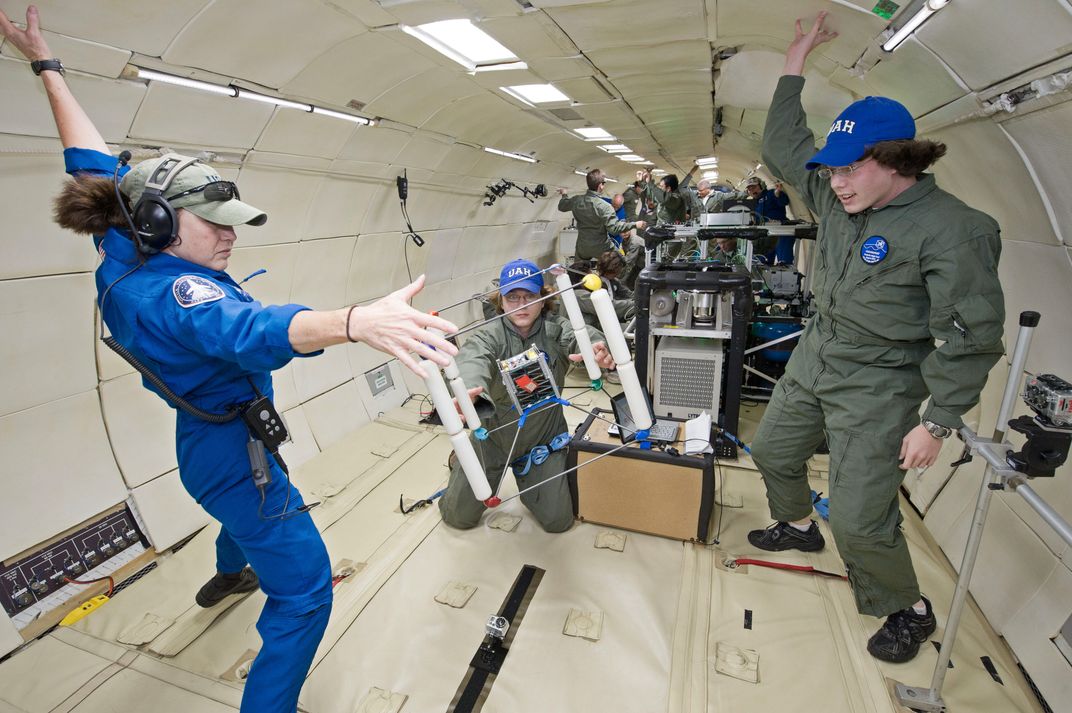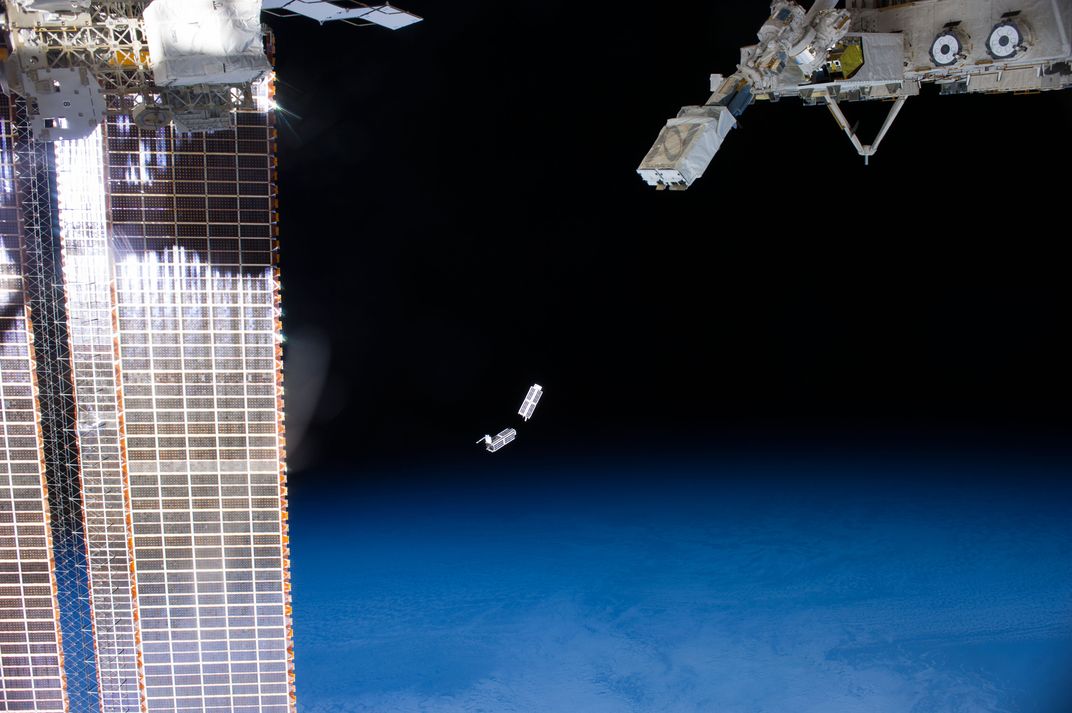CubeSats to the Moon (Mars and Saturn, Too)
The next generation of planetary explorers.
/https://tf-cmsv2-smithsonianmag-media.s3.amazonaws.com/filer/da/69/da698b35-e460-4c27-947c-505c32eff7ce/planetary_cubesats-main.jpg)
When it’s ready for launch, your typical spacecraft is transported to the launch vehicle in a special truck, or on its own airplane, or in a railway car. It usually has to be packed in something at least the size of a shed. Carl Brandon, a physics professor at Vermont Technical College, stowed his in the overhead compartment of a commercial airliner.
“It took me about two minutes to go through security,” he says. When they heard what had just gone through the X-ray machine, the TSA agents at Burlington’s airport flocked to him. “They all wanted to hear about the CubeSat,” says Brandon.
Vermont Tech’s satellite—its first ever—is one of hundreds of tiny spacecraft projects under development that may change how we explore the solar system. This particular one won’t travel far, but after being launched into Earth orbit last November, the Vermont Lunar CubeSat began testing navigational equipment that, in theory, could guide it to the moon. If all goes well, in a few years Brandon and his team will try to turn theory to reality with a slightly larger version.
Slightly larger, in this case, would mean 10 by 10 by 30 centimeters, about the size of a loaf of bread. The satellite now in orbit is a cube only 10 centimeters on a side, but it has the same kind of equipment you’d expect on a much larger spacecraft: star-tracking camera, GPS, gyroscope, accelerometer, magnetometer, solar panels, computer, and radio transceiver.
Small spacecraft are nothing new—the first satellite launched by the United States in 1958, Explorer 1, weighed only about 30 pounds. But with electronics getting more compact—a trend driven largely by demand for things like smartphones—smallsats can now perform functions, such as photographing Earth from space, that used to be possible only with large, expensive spacecraft (see “Spysats for Everyone,” Sept. 2013). For some jobs, little spacecraft may even be better.
Case in point: Saturn’s rings. The $3 billion Cassini spacecraft, which has gathered the most detailed information about Saturn to date, can’t risk coming close enough to the rings to study the icy particles they’re made of. One wayward particle and boom, there goes Cassini. Some researchers have suggested sending a large spacecraft to hover above the rings and take detailed images, but the fuel requirements for such maneuvers would be enormous, says Matthew Tiscareno, who works with Cassini’s imaging team at Cornell University in New York.
That’s why he and other colleagues at Cornell propose something simpler, smaller, and about 1,000 times cheaper. A swarm of tiny spacecraft, not unlike Vermont Tech’s Lunar CubeSat, could be injected directly into Saturn’s rings, where they would orbit along with the ice particles. Those CubeSats could then release hundreds of even smaller spacecraft, called chipsats, that would “tag” individual ice particles, recording basic information about their composition, density, and motion within the rings.
In some ways, this would be the ideal way to study the rings: gathering lots of data from lots of little sources. You actually don’t want something bigger, says Tiscareno. “If you had a spacecraft the size of a Volkswagen or—you know, Cassini’s the size of a schoolbus—it would disrupt the environment that it’s trying to measure a lot more than a CubeSat would.” Not all the tiny spacecraft would likely survive bumping around inside Saturn’s rings, but even if only one in four sent back data, he says, the mission would be a success. It’s the buckshot approach to planetary science.
The first CubeSats (called picosatellites if they weigh less than a kilogram) were developed in 1999 by Jordi Puig-Suari and Bob Twiggs at California Polytechnic State and Stanford universities, respectively. The inventors wanted a project that would allow students to build functioning satellites within just a couple of school years. Later, students at Cal Poly designed a Poly-Picosatellite Orbital Deployer, or P-POD, which packs several CubeSats together for easy release in orbit. The P-POD fits inside the unused volume on rockets delivering other, larger payloads to space.
Compactness is one advantage of the CubeSat form, but the real benefit is cost. Vermont’s CubeSat cost about $50,000, several orders of magnitude less than a typical NASA spacecraft, which means that CubeSats have a much better chance than bigger satellites do of actually flying. “The new age that’s dawning right now comes at a time when billion-dollar flagship missions are not being funded at the rate that they were in the past,” says Paula Pingree, an engineer at NASA’s Jet Propulsion Laboratory in Pasadena, California, who has designed electronics and instruments for expensive missions like Cassini and now oversees several of JPL’s CubeSat projects. “The CubeSat opportunity does give us a chance to get that access to space,” she says.
Thinking small also spurs creativity, according to Robert Staehle, another seasoned JPL engineer, who has spearheaded a project to brainstorm planetary CubeSat missions. “The fact that you have this limited-size box is part of the engine of innovation,” he says. “If you can’t figure out how to get it in the size box it is, then you’re not going [to space]. And that has been a tremendous forcing function of innovation.” Cheaper, simpler spacecraft give engineers the freedom to fail. It’s okay to lose a few CubeSats if they can be easily replaced, and learning from failure is often how technology gets better faster.
Now it’s up to CubeSat aficionados to show that small satellites can take on big jobs, like planetary exploration. Among the most attractive potential missions are those that require more than one spacecraft in more than one place. Besides infiltrating Saturn’s rings, swarms of CubeSats could fan out and explore hundreds of near-Earth asteroids, or create a network to observe electrical storms on Mars or view regions on the sun not visible from Earth.
CubeSats would also make good add-ons to larger missions. They could ride along on the mothership, then be deployed to do jobs too dangerous for the main spacecraft, like flying kamikaze into a comet’s tail or into the plume of a volcano on Jupiter’s moon Io. CubeSats could even be linked together at their destination to form a single, more capable spacecraft. The California Technical Institute is developing a self-assembling space telescope made up of six CubeSats and another hexagonal-shaped nanosatellite.
That’s another thing about CubeSats: The affordability of these spacecraft is drawing more—and more diverse—engineering talent to the field. What had long been the exclusive domain of NASA, big aerospace companies, and a few well-funded universities is now within reach of schools like St. Louis University in Missouri and Salish Kootenai College in Montana; students can be involved with developing a working spacecraft through every stage, from concept to launch. Countries that have never before made space headlines, like Colombia, Hungary, Estonia, and Peru, also are putting up their first satellites—all CubeSats.
Small startup companies are getting in on the action too. Pumpkin, Inc., based in San Francisco, sells a CubeSat Kit that lets engineers add their own payload and systems to a small, standardized bus. Raptor Space Services in Mountain View, California, is working on a vehicle to carry CubeSats from the International Space Station to higher orbits.
“[Small satellites] are probably the most exciting area of the space business right now,” says Robert Hoyt, who started Seattle-based Tethers Unlimited in 1994, just as the CubeSat revolution was about to begin. With grants from NASA and the Department of Defense, the company is developing tools to boost the capabilities of CubeSats, including a foldable, high-output solar power array and a deployable dish antenna that greatly increases communications range—both of which can be stowed in CubeSat-size compartments until they’re deployed.
New methods of financing space projects are helping to expand the number of players in the field. Ben Longmier, an aerospace engineering professor at the University of Michigan, recently led a couple of Kickstarter campaigns to fund development of his CubeSat propulsion system, a plasma thruster fueled by water and other propellants. While the initial campaign failed to meet its fundraising goal, it gained the project a lot of exposure, and the second time around Longmier and his team raised almost twice their $50,000 goal.
The CubeSat revolution will need many such creative minds to pull off cheap planetary exploration. The challenge with sending shoebox-size spacecraft into deep space is how to fit all the necessary equipment for propulsion, long-range communications, radiation protection, data processing, and power—and still have room for cameras and spectrometers.
In the DIY culture of CubeSat builders, simple (read “cheap”) is good. “Why spend a million dollars when you can use a toaster oven?” says Ali Roland, who worked as an undergraduate on St. Louis University’s Close Orbital Propellant Plume Element Recognition (COPPER) satellite. Roland and others use a toaster oven to “bake” CubeSats before launch to prevent the chemical outgassing that can interfere with instruments in space. But given all the pitfalls of operating in space, success is far from guaranteed. COPPER was launched in November (along with Vermont Tech’s Lunar CubeSat) as a first step toward developing automatic imaging systems that could help CubeSats recognize and dock with one another. Unfortunately, right after launch, the team lost contact with their spacecraft.
At JPL, Staehle is well aware of the time and money that go into preventing such failures on NASA planetary missions. Yet he hopes CubeSats will create new ways of approaching familiar problems. His favorite potential application is a low-tech sample return from Phobos, the larger of Mars’ two moons. Because the moon’s gravity is relatively weak, there’s no need for rocket thrust to escape the surface. Staehle proposes using a simple spring. One CubeSat would land on the surface, scoop up sediment in a small container, and spring the container into orbit, where another CubeSat would catch it and retrieve it for return to Earth, in a kind of robotic alley-oop. Staehle says the idea started as a joke at his CubeSat project’s weekly meeting: “Somebody said, ‘Well, you can’t do a Phobos sample return with CubeSats,’ and everyone laughed in agreement. Then somebody said, ‘Well wait a minute, let’s look at this.’ In the space of 10 minutes, the whole idea came together at a very conceptual level.”
Another JPL-led project, the Lunar Flashlight, would search for ices in lunar polar craters by using its solar sail (which is primarily for propulsion) as a mirror to shine sunlight into shaded regions, then scan the area with a spectrometer.
Each CubeSat project seems to come up with another invention. An MIT team is working on an inflatable radio antenna that transmits 10 times faster and seven times farther than existing CubeSat antennas. Others at MIT are working on a penny-size thruster that shoots ionized particles out of hundreds of microscopic metallic tips. It would generate very little thrust in the short term, but plenty over a multi-year cruise to the outer solar system.
The main challenge for small spacecraft today is proving that they can be trusted on long-range, high-stakes missions. “You can do a fair amount of testing on the ground,” says Hoyt, “but nobody’s really going to trust it until it’s flown.”
That proof, in turn, depends on launch opportunities. Many tests of interplanetary-grade technology can be conducted in low Earth orbit, and NASA’s Educational Launch of Nanosatellites (ELaNa) program, part of the agency’s broader CubeSat initiative, finds free rides for academic CubeSats on rockets that are already going to orbit. For other tests—say, confirming that your CubeSat’s avionics are adequately protected from deep-space radiation—you have to go further. Russ Cox, a space entrepreneur who organizes an annual conference on sending CubeSats to the moon, says, “If we are going to be doing anything in deep space, we are going to learn how to do it at the moon first.”
Here’s where the flight opportunities start to get rare. NASA’s new Space Launch System, still under construction, is slated to carry 12 CubeSats, including the Lunar Flashlight, on its first test flight to the moon. But that launch won’t happen until 2017 at the earliest. Meanwhile, the agency is considering awarding a few million dollars in prize money for CubeSat missions to the moon and beyond.
The first CubeSat to make it beyond Earth orbit may be JPL’s Interplanetary NanoSpacecraft Pathfinder In Relevant Environment (INSPIRE), two identical CubeSats that will be placed into a solar orbit. The team will load each with a miniaturized X-Band radio transponder and a couple of off-the-shelf processing boards to see how they perform. And, to test the ability of a nanosatellite to gather data in deep space, each CubeSat will carry a magnetometer to gauge the solar wind, a star-tracker for orientation, and an imager. INSPIRE’s launch date hasn’t been set, but is expected within the next two years.
What if the experiments don’t work? It’s possible that some things simply can’t be done with a tiny spacecraft, including exploring the solar system.
“It’s a big question right now where that threshold is,” says Pingree. She points out that on small satellites, there’s no room for backup systems, and miniaturized instruments may be more prone to failure. The longer and farther a spacecraft travels, the more important those factors become.
Until these questions are answered, most of the long-range CubeSat dreams of planetary scientists and engineers will remain conceptual. Perhaps the most ambitious dream is the student-led, crowd-funded Time Capsule to Mars, which aims to land a CubeSat containing millions of digitized photos and personal messages on the surface of Mars. For now, it’s in the baby steps of teams like those from Vermont Tech and St. Louis University that the revolution pushes forward.
“It’s no one group that’s making this actually be successful,” says Andy Klesh, who heads up the INSPIRE project. “We need everybody to kind of move along with us.”
One of INSPIRE’s goals will be to snap a photo of Earth from afar, a kind of visual proof that CubeSats belong in deep space. “If we were actually able to take an Earthrise image—just like Apollo took the Earthrise image from the moon—from this spacecraft, I think that would really be an eye-opening experience for many people, saying these CubeSats can do a lot more than what we thought they could,” says Klesh.
Cox believes the main force limiting development of CubeSats for interplanetary missions is the space industry’s conservative nature. “There really isn’t anything getting in anybody’s way, other than history, other than the fact that you could not do this five years ago,” he says.
On that cold night last November, Carl Brandon watched Vermont Tech’s CubeSat launch from NASA’s Wallops Flight Facility in Virginia. Standing alongside two of his undergraduate students (the bulk of his team) and his nine-year-old son, Jack, he had the feeling that the nature of space exploration is changing. As the Minotaur 1’s solid fuel booster thundered off the pad, the students, Dan and India, gave each other an understated but heartfelt high-five.
Jack watched until the rocket disappeared, then asked, “Now what?”
Now, we see if it works.




